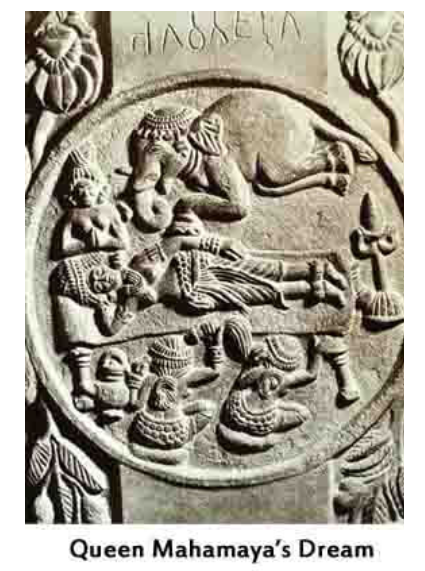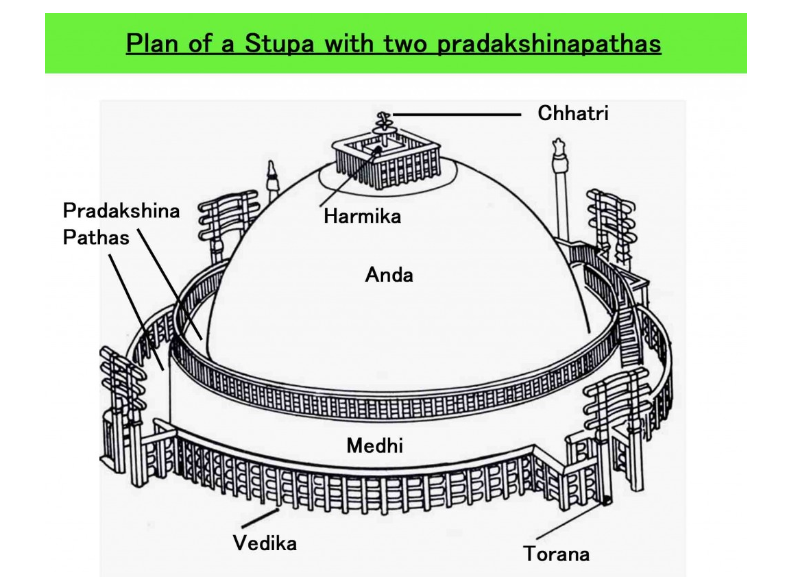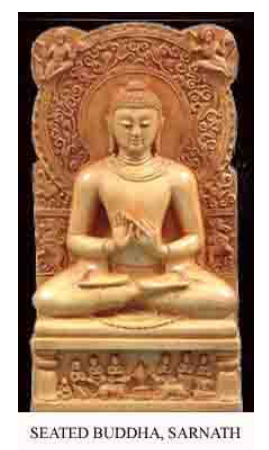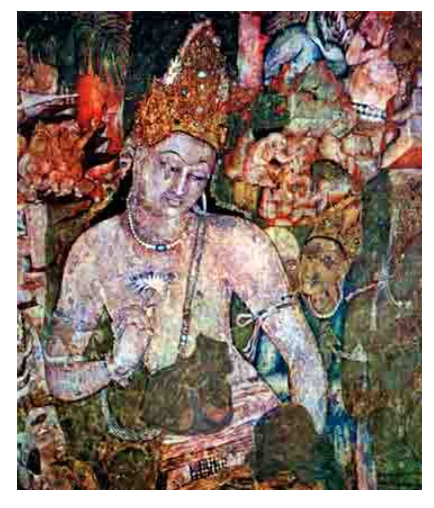Post Mauryan Art
Introduction
After the Mauryan Empire fell in the 2nd Century BC, different rulers ruled the areas that were once part of the Mauryan Empire. In the north and central parts of India, there were rulers like the Shungas, Kanvas, Kushanas, and Guptas. In the southern and western parts of India, rulers like the Satavahanas, Abhiras, Ikshvakus, and Vakatakas took charge.
During this time, new religious groups like the Shaivas and the Vaishnavas became more important.
Some beautiful sculptures from this period can be found in places like Bharhut and Vidisha in Madhya Pradesh, Mathura in Uttar Pradesh, Bodhgaya in Bihar, Jaggayyapeta in Andhra Pradesh, Bhaja and Pavani in Maharashtra, and Khandagiri and Udaigiri in Odisha.
Post-Mauryan Art and Architecture
Bharhut
- The Bharhut sculptures are tall and resemble the images of Yaksha and Yakshini from the Mauryan period.
- They use low relief to create a sense of depth while keeping the lines clear.
- These sculptures tell stories, and the main events are emphasized for clarity.
- Over time, more characters appear in the narratives, making use of available space effectively.
- The sculptures at Bharhut show how artists used pictures to tell stories.
- For instance, one narrative depicts Queen Mahamaya (Siddhartha Gautama's mother) having a dream.
- She is lying on a bed, and there's an elephant heading toward her womb.
- In contrast, a Jataka story is simpler, where events are grouped by their location.
- For example, in the Ruru Jataka, the Bodhisattva deer rescues a man on his back. These Jataka stories were often part of stupa decorations.
- As stupas were built across the country, different regions developed their unique artistic styles.

Sanchi
- In the next phase of cultural development at places like Sanchi stupa-1, Mathura, and Vengi in Andhra Pradesh, some interesting changes in style took place.
- At Sanchi stupa-1, there's a path where people can walk around, both above and below. There are four beautifully decorated gateways called Torans. They show different events from Buddha's life and Jataka stories.
- The figures on these gateways stand out, and they look natural. They don't look stiff.
- The storytelling becomes more detailed, and the carving techniques are more advanced compared to Barhut.
- Symbols are used to represent Buddhas or past Buddhas (there are 24 Buddhas in texts, but only the first one, Dipankar, and the last six are shown in pictures).
- Even though the stories become more detailed, the depiction of dream episodes, like Queen Mayadevi's dream, remains simple.
Stupa-1, Sanchi (Madhya Pradesh)
- Sanchi, located near Bhopal in Madhya Pradesh, is a UNESCO World Heritage Site known for its stupas. Among these stupas, three are particularly significant:
- Stupa-1 is believed to house the relics of Buddha. It's renowned for its architecture and elaborate carvings on its gateways, known as torans.
- Stupa-2 contains relics of ten less well-known Arhats, who are spiritually advanced individuals in Theravada Buddhism. They belong to three different generations.
- Stupa-3 holds the relics of Sariputta and Mahamoggallana, who were disciples of Gautama Buddha.
- Stupa-1 is considered the finest example of stupa architecture and has a unique upper circumambulatory path. The four gateways are adorned with intricate sculptures.
- In Sanchi, Buddha is symbolically represented through various elements like an empty throne, feet, chhatra, and stupas. Torans are present in all four directions and show stylistic variations that suggest their development over time, possibly starting from the first century BCE.
- Although stupa-1 is the oldest, the carvings on the Vedika (fence) of stupa-2 are older than those on stupa-1.
- Jataka stories, which are tales of Buddha's previous lives, are an essential part of the artistic narratives at Sanchi.
- Despite their small size, the figures in Sanchi's sculptures appear naturalistic. The site features guardian images, and the salabhanjika sculptures, depicting women holding tree branches or plates, are particularly notable.
- Each torana consists of two vertical pillars and three horizontal bars on the top. Both sides of each horizontal bar are decorated with various sculptural themes, and the images of Salabhanjika support the lowermost horizontal bar from below.

Post-Mauryan Trends in Indian Art
After the Mauryan period, different local art styles developed, and they mixed with outside influences.
Mathura, Sarnath, Amaravati and Gandhara Schools
In the time after the Mauryan period, different art styles emerged in different places:
- Gandhara Art: In the region of Gandhara, which had interactions with Greek and Roman cultures through trade and conquest, the art was influenced by these foreign styles. Gandhara art is known for its realistic depictions of Buddha and other gods, often wearing Greek-inspired clothing and having features that look real.
- Mathura Art: In the city of Mathura, a significant art center, they focused on creating images of Indian deities, especially Buddha, using a more local style. The sculptures had gentle and graceful features, emphasizing spirituality and deep emotions.
- Amravati Art: The Amaravati stupa in what is now Andhra Pradesh is from the Satavahana period and is famous for its detailed relief sculptures. These sculptures told stories from Buddha's life and Jataka tales. Amravati art is known for its intricate details and its ability to tell stories.
Each of these art styles has its own unique characteristics and examples.
Seated Buddha, Katra Mount, Mathura
- This sculpture of Buddha comes from a place called Katra Mount in Mathura and dates back to the Kushan period.
- It shows Buddha sitting down with two of his helpers. He's sitting in a special way, with his legs crossed, and his right hand is raised as a sign of protection.
- Buddha's face is round with full cheeks, and his hair is tied in a knot on top of his head.
- The sculptures from Mathura during this time are light and show Buddha with a soft body.
- He's wearing a garment that covers only one shoulder.
- The two helpers are called Padmapani and Vajrapani Bodhisattvas.
- One is holding a lotus flower, and the other has a Vajra or Thunderbolt.
- There's a big circle behind Buddha's head, and it's decorated with simple shapes.
- Above this circle, there are two flying figures, placed diagonally.

Seated Buddha at Sarnath
- This is a sculpture of Buddha from Sarnath, made of a special kind of stone called Chunar sandstone. It's from around the late fifth century CE.
- In the sculpture, Buddha is sitting on a throne with his legs crossed.
- This particular scene is called "Dhammachakrapravartana," which is when he gave his first sermon. You can tell it's this moment because there are certain symbols on the throne.
- Under the throne, there's a wheel in the center and two deer on either side, along with his followers.
- This scene represents the important event of Buddha preaching his teachings.
- This sculpture is considered one of the best examples of the Sarnath School of Sculpture.
- Buddha's face is round, his eyes are half-closed, and his lower lip sticks out a bit.
- His cheeks are not as full as in older images from the Kushana period in places like Mathura.
- His hands are shown in a special way, called "Dhamma Chakra Pravartana Mudra." The knot of hair on top of his head is round and curly.
- In ancient India, the goal of sculptures like this was to show Buddha as a great human who had reached a state of peace and freedom from anger and hate called Nibbana.

Buddha Head, Taxila, Gandhara
- The Buddha head from Taxila in the Gandhara region, which is in Pakistan, is from around the second century CE during the time of the Kushanas.
- It has a unique style that came about during the Gandhara period, combining Greek and Roman influences. The Buddha's head has distinct Hellenistic features.
- His hair is curly and thick, with detailed strokes over it.
- The forehead is prominent, and the eyes are partly closed.
- Unlike images from other parts of India, the face and cheeks are not round.
- The figures from the Gandhara region tend to have a bit of weight to them.
- The ears, especially the earlobes, are elongated. The sculpture emphasizes clear lines and sharp outlines, with a smooth surface that gives a very expressive quality.
- The main focus is on the calm expression of the Buddha's face.
- The way the face is shaped adds a natural and three-dimensional look.
- The Gandhara style is known for blending elements from Acamenian, Parthian, and Bactrian traditions with the local style. This reflects the unique geopolitical conditions of the region.
- It's worth noting that the northwestern part of India, now in Pakistan, has had continuous human habitation from ancient times to the historic period.
Amaravati Stupa, Andhra Pradesh
- Vengi in Andhra Pradesh has many stupas like Jagayyapetta, Amaravati, Bhattiprolu, Nagarjunakonda, etc.
- Amaravati has a Maha chaitya and has many sculptures.
- Like the Sanchi stupa, the Amaravati stupa also has Pradakshina Patha enclosed within a Vedika on which many narrative sculptures are depicted.
- The domical stupa structure is covered with a relief stupa sculpture slab which is a unique feature.
- The Torana of the Amaravati stupa has disappeared over some time.
- Like Sanchi, the early phase is devoid of Buddha images but during the later phase (2nd and 3rd CE); the Buddha images are carved on the drum slabs and at many other places.
- The sculptural form in this area is characterized by intense emotions.
- Bodies are shown with three bends (Tribanga), and the sculpture composition is more complex than Sanchi.
- The Dream of Queen Mayadevi has also been depicted here.
- Independent Buddha images are also found at Amaravati, Nagarjunakonda, and Guntapalle.
- Guntapalle is a rock-cut cave near Eluru, Andhra Pradesh.
- In Karnataka, Sannati is the largest stupa excavated yet.
- Along with the images of Buddha, other Buddhist images of Bodhisattvas like Avalokiteswara, Padmapani, Vajrapani, Amitabha, and Maitreya Buddha started getting sculpted.
Gandhara |
Mathura |
Amaravati |
|
|
|
Caves in Western India
- Western India has numerous Buddhist caves dating from the second century BCE and onward.
- Three types of architectural designs were created in these caves:
- Apsidal vault-roof chaitya hall (found at Ajanta, Pitalkhora, Bhaja)
- Apsidal vault-roof pillarless hall (found at Thana-Nadsur)
- Flat-roofed quadrangular hall with a circular chamber at the back (found at Kondivite)
- Chaitya caves typically have a stupa at the back.
- Modifications were made in the first century BCE, changing the apsidal vault-roof hall into a rectangular one with a stone screen wall as a facade.
- The largest rock-cut chaitya hall was excavated in Karla, Maharashtra.
- Viharas are found in all the caves.
- Viharas consist of a veranda, a hall, and cells along the walls.
- Early vihara caves often feature interior decorations like chaitya arches and vedika designs above the cell doors.
- Some later viharas added a stupa to become Chaitya-Viharas.
- Junnar, Maharashtra, has the most cave excavations with over 200 caves around the town's hills, while Kanheri in Mumbai has 108 caves.
- A popular vihara cave in Junnar is known as Ganeshi due to the installation of a Ganesh image in a later period.
- Initially, it was believed these caves belonged to the Theravada branch of Buddhism due to the absence of Buddha images.
- However, the discovery of the Konkan Maurya inscription mentioning the Saka era 322 (400 CE) confirmed ongoing cave activity with Buddha images.
- Many caves have been converted into modern Hindu shrines and are now places of worship.
Ajanta Caves
- Ajanta is a famous cave site in western India.
- Location: Aurangabad district, Maharashtra
- Total caves: 29, including 4 chaitya caves
- Features a large Chaitya-Vihara with sculptures and paintings (murals)
- Unique for preserving art from the 1st century BCE to the 5th century BCE
- Some Vihara caves remain unfinished
- Important patrons: Varahadeva, Upendra Gupta, Buddhabadra, and Mathurasena
- Major paintings found in caves 1, 2, 16, and 17
- Paintings exhibit various styles
- Figures in the paintings are solid, similar to sculptures in western India
- Cave excavation and painting were done together; dating follows cave excavation dates
- Most finished caves have paintings, but few remain
- Paintings depict a diverse society with various skin colors
- Themes include events from Buddha's life, the Jatakas, and Avadanas
- Jungle and palace events are separated in the paintings
- Frequent images of Padmapani and Vajrapani are found in Ajanta.
Padmapani Bodhisattva
- The painting is from the late first century CE.
- Bodhisattva holds a lotus and has broad shoulders, giving a sense of movement.
- Soft modeling and merged outlines create a 3D effect.
- Colors used include light red, brown, green, and blue.
- On the other side is Vajrapani Bodhisattva with a vajra in his right hand and a crown.
- These Bodhisattvas are painted as shrine guardians.
- Similar paintings can be found in other caves, but those in Cave No. 1 are some of the best-preserved in Ajanta.

Mara Vijaya, Cave No. 26
- The theme of Mara Vijaya is in Ajanta's caves, but only cave no. 26 has a sculpted version on its right wall.
- The panel displays the Buddha in the middle, with Mara's army surrounding him.
- This scene is about enlightenment, and Mara represents desire, which is like a challenge to the Buddha's mind during his enlightenment.
- The Buddha is shown with his right hand pointing to the earth as a witness to his generosity.
- The image of Mara shows him thinking about how to disrupt Siddhartha, the Buddha before his enlightenment.
Ellora Caves
- Ellora is an important cave site near Aurangabad.
- It's about 100 km away from Ajanta.
- There are 32 caves for Buddhists, Brahmanical, and Jains.
- It's unique because it has monasteries for three religions dating from the 5th to 11th century CE.
- Ellora is also special because it combines many different art styles.
- 12 Buddhist caves have lots of Vajrayana Buddhist images.
- Buddhist caves are large and come in single, double, and triple stories. The triple-story design is unique.
- Pillar designs start in the Buddhist caves and become more ornate in the Jain caves, especially from the 9th century CE.
- Most Brahmanical caves are for Shaivism, and they show various avatars of Vishnu.
- Cave no.16 is called Kailas Leni or Kailasa temple.
- It's a temple carved from a single rock, made in the 8th century CE.
- A famous sculpture here shows Ravana trying to lift Mount Kailash with all his strength, a significant piece in Indian art.
Elephanta Caves
- Elephanta caves are on Elephanta Island near Mumbai. They started as a Buddhist place but later became mainly Shaivite.
- These caves are from the same time as Ellora.
- Another interesting cave site is Bagh, near Indore in Madhya Pradesh.
- The Bagh cave also has paintings, including one showing dancers that look like the Garba Dance in North India, which started in Gujarat.
- Rock-cut caves are found in the Deccan region, not only in Maharashtra but also in places like Karnataka (like Badami and Aihole, sponsored by the Chalukyas), Andhra Pradesh (around Vijayawada), and Tamil Nadu (especially at Mahabalipuram, supported by the Pallavas).
- In the past, these caves were supported by the public, but after the sixth century CE, they depended more on political support.
- One notable sculpture is the Maheshmurti, with Shiva in the center and the heads of Bhairava and Uma on each side.
Caves in Eastern India
- In eastern India, just like in the West, there are Buddhist caves.
- They are mainly found in the coastal areas of Andhra Pradesh and Odisha.
- One key site in Andhra Pradesh is Guntapalle, in the Eluru district.
- It's unique because it has structural stupas, viharas, and caves all in one place.
- Another important site in Andhra Pradesh is Ram Perampalam.
- Near Visakhapatnam, in Anakapalli, there is a massive rock-cut stupa carved out of a hill during the 4th-5th century CE.
- It's special because it's the biggest rock-cut stupa in the country.
- Odisha has the Udayagiri-Khandagiri caves, and these caves are spread out. They have inscriptions from Kaharvela Kings.
- The caves were made for Jain monks.
- Many of these caves are small, with the top part of each cell decorated with a series of Chaitya arches and stories that are part of the local culture.
Post Mauryan Art: Early temples in India
In the early days, alongside the building of stupas, temples for Brahmanical gods started to appear. These temples told stories from the Puranas. Each temple had a main image of a god.
Temples came in three types:
- Sandhara type: with a path to walk around it.
- Nirandara type: without a path.
- Sarvatobhadra type: accessible from all sides.
Some important temple sites from this time were Deogarh in Uttar Pradesh, Eran, Nachna-kuthara, and Udayagiri near Vidisha in Madhya Pradesh.
These temples were quite simple, with a veranda, a hall, and a shrine at the back.


